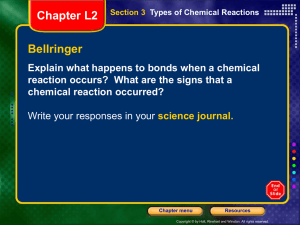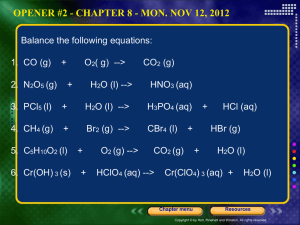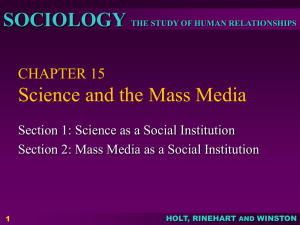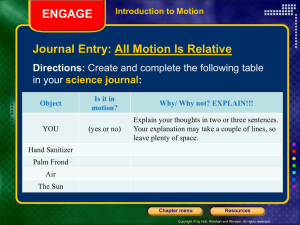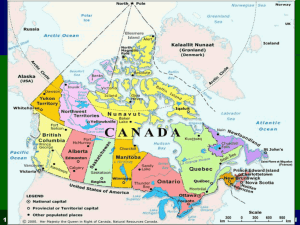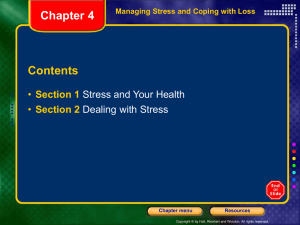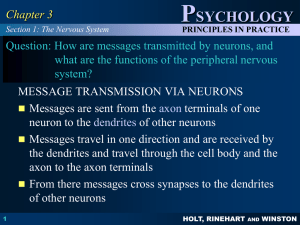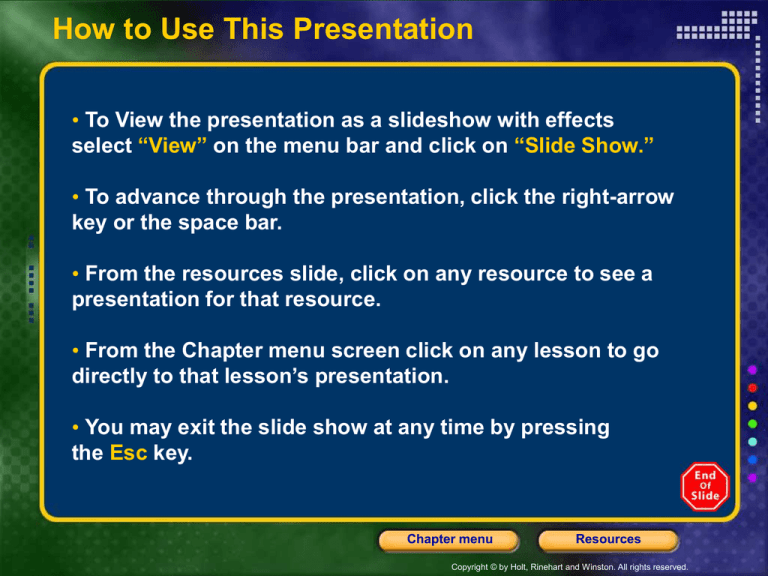
How to Use This Presentation
• To View the presentation as a slideshow with effects
select “View” on the menu bar and click on “Slide Show.”
• To advance through the presentation, click the right-arrow
key or the space bar.
• From the resources slide, click on any resource to see a
presentation for that resource.
• From the Chapter menu screen click on any lesson to go
directly to that lesson’s presentation.
• You may exit the slide show at any time by pressing
the Esc key.
Chapter menu
Resources
Copyright © by Holt, Rinehart and Winston. All rights reserved.
Resources
Chapter Presentation
Transparencies
Visual Concepts
Sample Problems
Standardized Test Prep
Chapter menu
Resources
Copyright © by Holt, Rinehart and Winston. All rights reserved.
Chapter 17
Electrical Energy and Current
Table of Contents
Section 1 Electric Potential
Section 2 Capacitance
Section 3 Current and Resistance
Section 4 Electric Power
Chapter menu
Resources
Copyright © by Holt, Rinehart and Winston. All rights reserved.
Chapter 17
Section 1 Electric Potential
Objectives
• Distinguish between electrical potential energy,
electric potential, and potential difference.
• Solve problems involving electrical energy and
potential difference.
• Describe the energy conversions that occur in a
battery.
Chapter menu
Resources
Copyright © by Holt, Rinehart and Winston. All rights reserved.
Chapter 17
Section 1 Electric Potential
Electrical Potential Energy
• Electrical potential energy is potential energy
associated with a charge due to its position in an
electric field.
• Electrical potential energy is a component of
mechanical energy.
ME = KE + PEgrav + PEelastic + PEelectric
Chapter menu
Resources
Copyright © by Holt, Rinehart and Winston. All rights reserved.
Chapter 17
Section 1 Electric Potential
Electrical Potential Energy, continued
• Electrical potential energy can be associated with a
charge in a uniform field.
• Electrical Potential Energy in a Uniform Electric Field
PEelectric = –qEd
electrical potential energy = –(charge) (electric field strength)
(displacement from the reference point in the direction of the field)
Chapter menu
Resources
Copyright © by Holt, Rinehart and Winston. All rights reserved.
Chapter 17
Section 1 Electric Potential
Electrical Potential Energy
Chapter menu
Resources
Copyright © by Holt, Rinehart and Winston. All rights reserved.
Chapter 17
Section 1 Electric Potential
Potential Difference
• Electric Potential equals the work that must be
performed against electric forces to move a charge
from a reference point to the point in question,
divided by the charge.
• The electric potential associated with a charge is the
electric energy divided by the charge:
PEelectric
V
q
Chapter menu
Resources
Copyright © by Holt, Rinehart and Winston. All rights reserved.
Chapter 17
Section 1 Electric Potential
Potential Difference, continued
• Potential Difference equals the work that must be
performed against electric forces to move a charge
between the two points in question, divided by the
charge.
• Potential difference is a change in electric potential.
PEelectric
V
q
change in electric potential energy
potential difference
electric charge
Chapter menu
Resources
Copyright © by Holt, Rinehart and Winston. All rights reserved.
Chapter 17
Section 1 Electric Potential
Potential Difference
Chapter menu
Resources
Copyright © by Holt, Rinehart and Winston. All rights reserved.
Chapter 17
Section 1 Electric Potential
Potential Difference, continued
• The potential difference in a uniform field varies with
the displacement from a reference point.
• Potential Difference in a Uniform Electric Field
∆V = –Ed
potential difference = –(magnitude of the electric
field displacement)
Chapter menu
Resources
Copyright © by Holt, Rinehart and Winston. All rights reserved.
Chapter 17
Section 1 Electric Potential
Sample Problem
Potential Energy and Potential Difference
A charge moves a distance of 2.0 cm in the
direction of a uniform electric field whose
magnitude is 215 N/C.As the charge moves, its
electrical potential energy decreases by 6.9 10-19
J. Find the charge on the moving particle. What is
the potential difference between the two
locations?
Chapter menu
Resources
Copyright © by Holt, Rinehart and Winston. All rights reserved.
Chapter 17
Section 1 Electric Potential
Sample Problem, continued
Potential Energy and Potential Difference
Given:
∆PEelectric = –6.9 10–19 J
d = 0.020 m
E = 215 N/C
Unknown:
q=?
∆V = ?
Chapter menu
Resources
Copyright © by Holt, Rinehart and Winston. All rights reserved.
Chapter 17
Section 1 Electric Potential
Sample Problem, continued
Potential Energy and Potential Difference
Use the equation for the change in electrical potential
energy.
PEelectric = –qEd
Rearrange to solve for q, and insert values.
PEelectric
(–6.9 10 –19 J)
q–
–
Ed
(215 N/C)(0.020 m)
q 1.6 10 –19 C
Chapter menu
Resources
Copyright © by Holt, Rinehart and Winston. All rights reserved.
Chapter 17
Section 1 Electric Potential
Sample Problem, continued
Potential Energy and Potential Difference
The potential difference is the magnitude of E times
the displacement.
V –Ed –(215 N/C)(0.020 m)
V –4.3 V
Chapter menu
Resources
Copyright © by Holt, Rinehart and Winston. All rights reserved.
Chapter 17
Section 1 Electric Potential
Potential Difference, continued
• At right, the electric potential at point A depends on
the charge at point B and
the distance r.
• An electric potential exists
at some point in an electric
field regardless of whether
there is a charge at that
point.
Chapter menu
Resources
Copyright © by Holt, Rinehart and Winston. All rights reserved.
Chapter 17
Section 1 Electric Potential
Potential Difference, continued
• The reference point for potential difference near a
point charge is often at infinity.
• Potential Difference Between a Point at Infinity and a
Point Near a Point Charge
q
V kC
r
potential difference = Coulomb constant
value of the point charge
distance to the point charge
• The superposition principle can be used to calculate
the electric potential for a group of charges.
Chapter menu
Resources
Copyright © by Holt, Rinehart and Winston. All rights reserved.
Chapter 17
Section 1 Electric Potential
Superposition Principle and Electric Potential
Chapter menu
Resources
Copyright © by Holt, Rinehart and Winston. All rights reserved.
Chapter 17
Section 2 Capacitance
Objectives
• Relate capacitance to the storage of electrical
potential energy in the form of separated charges.
• Calculate the capacitance of various devices.
• Calculate the energy stored in a capacitor.
Chapter menu
Resources
Copyright © by Holt, Rinehart and Winston. All rights reserved.
Chapter 17
Section 2 Capacitance
Capacitors and Charge Storage
• A capacitor is a device that is used to store electrical
potential energy.
• Capacitance is the ability of a conductor to store
energy in the form of electrically separated charges.
• The SI units for capacitance is the farad, F, which
equals a coulomb per volt (C/V)
Chapter menu
Resources
Copyright © by Holt, Rinehart and Winston. All rights reserved.
Chapter 17
Section 2 Capacitance
Capacitors and Charge Storage, continued
• Capacitance is the ratio of charge to potential
difference.
Q
C
V
magnitude of charge on each plate
capacitance =
potential difference
Chapter menu
Resources
Copyright © by Holt, Rinehart and Winston. All rights reserved.
Chapter 17
Section 2 Capacitance
Capacitance
Chapter menu
Resources
Copyright © by Holt, Rinehart and Winston. All rights reserved.
Chapter 17
Section 2 Capacitance
Capacitors and Charge Storage, continued
• Capacitance depends on the size and shape of a
capacitor.
• Capacitance for a Parallel-Plate Capacitor in a
Vacuum
A
C 0
d
capacitance = permittivity of a vacuum
area of one of the plates
distance between the plates
0 permittivity of the medium 8.85 10 C /N m
–12
Chapter menu
2
Resources
Copyright © by Holt, Rinehart and Winston. All rights reserved.
Chapter 17
Section 2 Capacitance
Capacitors and Charge Storage, continued
• The material between a
capacitor’s plates can
change its capacitance.
• The effect of a dielectric
is to reduce the strength
of the electric field in a
capacitor.
Chapter menu
Resources
Copyright © by Holt, Rinehart and Winston. All rights reserved.
Chapter 17
Section 2 Capacitance
Capacitors in Keyboards
Chapter menu
Resources
Copyright © by Holt, Rinehart and Winston. All rights reserved.
Chapter 17
Section 2 Capacitance
Parallel-Plate Capacitor
Chapter menu
Resources
Copyright © by Holt, Rinehart and Winston. All rights reserved.
Chapter 17
Section 2 Capacitance
Energy and Capacitors
• The potential energy stored in a charged capacitor
depends on the charge and the potential difference
between the capacitor’s two plates.
1
PEelectric QV
2
electrical potential energy =
1
(charge on one plate)(final potential difference)
2
Chapter menu
Resources
Copyright © by Holt, Rinehart and Winston. All rights reserved.
Chapter 17
Section 2 Capacitance
Sample Problem
Capacitance
A capacitor, connected to a 12 V battery, holds 36
µC of charge on each plate. What is the
capacitance of the capacitor? How much electrical
potential energy is stored in the capacitor?
Given:
Q = 36 µC = 3.6 10–5 C
∆V = 12 V
Unknown:
C=?
PEelectric = ?
Chapter menu
Resources
Copyright © by Holt, Rinehart and Winston. All rights reserved.
Chapter 17
Section 2 Capacitance
Sample Problem, continued
Capacitance
To determine the capacitance, use the definition of
capacitance.
Q
3.6 10 –5 C
C
V
12 V
C 3.0 10 –6 F 3.0 µF
Chapter menu
Resources
Copyright © by Holt, Rinehart and Winston. All rights reserved.
Chapter 17
Section 2 Capacitance
Sample Problem, continued
Capacitance
To determine the potential energy, use the
alternative form of the equation for the potential
energy of a charged capacitor:
PEelectric
PEelectric
1
C( V )2
2
1
(3.0 10 –6 F)(12 V)2
2
PEelectric 2.2 10 –4 J
Chapter menu
Resources
Copyright © by Holt, Rinehart and Winston. All rights reserved.
Chapter 17
Section 3 Current and
Resistance
Objectives
• Describe the basic properties of electric current, and
solve problems relating current, charge, and time.
• Distinguish between the drift speed of a charge
carrier and the average speed of the charge carrier
between collisions.
• Calculate resistance, current, and potential
difference by using the definition of resistance.
• Distinguish between ohmic and non-ohmic
materials, and learn what factors affect resistance.
Chapter menu
Resources
Copyright © by Holt, Rinehart and Winston. All rights reserved.
Chapter 17
Section 3 Current and
Resistance
Current and Charge Movement
• Electric current is the rate at which electric charges
pass through a given area.
I
electric current =
Q
t
charge passing through a given area
time interval
Chapter menu
Resources
Copyright © by Holt, Rinehart and Winston. All rights reserved.
Chapter 17
Section 3 Current and
Resistance
Conventional Current
Chapter menu
Resources
Copyright © by Holt, Rinehart and Winston. All rights reserved.
Chapter 17
Section 3 Current and
Resistance
Drift Velocity
• Drift velocity is the the
net velocity of a charge
carrier moving in an
electric field.
• Drift speeds are
relatively small because
of the many collisions
that occur when an
electron moves through
a conductor.
Chapter menu
Resources
Copyright © by Holt, Rinehart and Winston. All rights reserved.
Chapter 17
Section 3 Current and
Resistance
Drift Velocity
Chapter menu
Resources
Copyright © by Holt, Rinehart and Winston. All rights reserved.
Chapter 17
Section 3 Current and
Resistance
Resistance to Current
• Resistance is the opposition presented to electric
current by a material or device.
• The SI units for resistance is the ohm (Ω) and is
equal to one volt per ampere.
• Resistance
V
I
potential difference
resistance
current
R
Chapter menu
Resources
Copyright © by Holt, Rinehart and Winston. All rights reserved.
Chapter 17
Section 3 Current and
Resistance
Resistance to Current, continued
• For many materials resistance is constant over a
range of potential differences. These materials obey
Ohm’s Law and are called ohmic materials.
• Ohm’s low does not hold for all materials. Such
materials are called non-ohmic.
• Resistance depends on length, cross-sectional area,
temperature, and material.
Chapter menu
Resources
Copyright © by Holt, Rinehart and Winston. All rights reserved.
Chapter 17
Section 3 Current and
Resistance
Factors that Affect Resistance
Chapter menu
Resources
Copyright © by Holt, Rinehart and Winston. All rights reserved.
Chapter 17
Section 3 Current and
Resistance
Resistance to Current, continued
• Resistors can be used to control the amount of
current in a conductor.
• Salt water and perspiration lower the body's
resistance.
• Potentiometers have variable resistance.
Chapter menu
Resources
Copyright © by Holt, Rinehart and Winston. All rights reserved.
Chapter 17
Section 4 Electric Power
Objectives
• Differentiate between direct current and alternating
current.
• Relate electric power to the rate at which electrical
energy is converted to other forms of energy.
• Calculate electric power and the cost of running
electrical appliances.
Chapter menu
Resources
Copyright © by Holt, Rinehart and Winston. All rights reserved.
Chapter 17
Section 4 Electric Power
Sources and Types of Current
• Batteries and generators supply energy to charge
carriers.
• Current can be direct or alternating.
– In direct current, charges move in a single
direction.
– In alternating current, the direction of charge
movement continually alternates.
Chapter menu
Resources
Copyright © by Holt, Rinehart and Winston. All rights reserved.
Chapter 17
Section 4 Electric Power
Energy Transfer
• Electric power is the rate of conversion of electrical
energy.
• Electric power
P = I∆V
Electric power = current potential difference
Chapter menu
Resources
Copyright © by Holt, Rinehart and Winston. All rights reserved.
Chapter 17
Section 4 Electric Power
Energy Transfer
Chapter menu
Resources
Copyright © by Holt, Rinehart and Winston. All rights reserved.
Chapter 17
Section 4 Electric Power
Energy Transfer, continued
• Power dissipated by a resistor
2
(
V
)
P I V I 2R
R
• Electric companies measure energy consumed in
kilowatt-hours.
• Electrical energy is transferred at high potential
differences to minimize energy loss.
Chapter menu
Resources
Copyright © by Holt, Rinehart and Winston. All rights reserved.
Chapter 17
Section 4 Electric Power
Relating Kilowatt-Hours to Joules
Chapter menu
Resources
Copyright © by Holt, Rinehart and Winston. All rights reserved.
Chapter 17
Standardized Test Prep
Multiple Choice
1. What changes would take place if the
electron moved from point A to point B in
the uniform electric field?
A. The electron’s electrical potential
energy would increase; its electric
potential would increase.
B. The electron’s electrical potential
energy would increase; its electric
potential would decrease.
C. The electron’s electrical potential
energy would decrease; its electric
potential would decrease.
D. Neither the electron’s electrical
potential energy nor its electric potential
would change.
Chapter menu
Resources
Copyright © by Holt, Rinehart and Winston. All rights reserved.
Chapter 17
Standardized Test Prep
Multiple Choice, continued
1. What changes would take place if the
electron moved from point A to point B in
the uniform electric field?
A. The electron’s electrical potential
energy would increase; its electric
potential would increase.
B. The electron’s electrical potential
energy would increase; its electric
potential would decrease.
C. The electron’s electrical potential
energy would decrease; its electric
potential would decrease.
D. Neither the electron’s electrical
potential energy nor its electric potential
would change.
Chapter menu
Resources
Copyright © by Holt, Rinehart and Winston. All rights reserved.
Chapter 17
Standardized Test Prep
Multiple Choice, continued
2. What changes would take place if the
electron moved from point A to point C in
the uniform electric field?
F. The electron’s electrical potential
energy would increase; its electric
potential would increase.
G. The electron’s electrical potential
energy would increase; its electric
potential would decrease.
H. The electron’s electrical potential
energy would decrease; its electric
potential would decrease.
J. Neither the electron’s electrical
potential energy nor its electric potential
would change.
Chapter menu
Resources
Copyright © by Holt, Rinehart and Winston. All rights reserved.
Chapter 17
Standardized Test Prep
Multiple Choice, continued
2. What changes would take place if the
electron moved from point A to point C in
the uniform electric field?
F. The electron’s electrical potential
energy would increase; its electric
potential would increase.
G. The electron’s electrical potential
energy would increase; its electric
potential would decrease.
H. The electron’s electrical potential
energy would decrease; its electric
potential would decrease.
J. Neither the electron’s electrical
potential energy nor its electric potential
would change.
Chapter menu
Resources
Copyright © by Holt, Rinehart and Winston. All rights reserved.
Chapter 17
Standardized Test Prep
Multiple Choice, continued
Use the following passage to answer questions 3–4.
A proton (q = 1.6 10–19 C) moves 2.0 10–6 m in the
direction of an electric field that has a magnitude of
2.0 N/C.
3. What is the change in the electrical potential energy
associated with the proton?
A. –6.4 10–25 J
B. –4.0 10–6 V
C. +6.4 10–25 J
D. +4.0 10–6 V
Chapter menu
Resources
Copyright © by Holt, Rinehart and Winston. All rights reserved.
Chapter 17
Standardized Test Prep
Multiple Choice, continued
Use the following passage to answer questions 3–4.
A proton (q = 1.6 10–19 C) moves 2.0 10–6 m in the
direction of an electric field that has a magnitude of
2.0 N/C.
3. What is the change in the electrical potential energy
associated with the proton?
A. –6.4 10–25 J
B. –4.0 10–6 V
C. +6.4 10–25 J
D. +4.0 10–6 V
Chapter menu
Resources
Copyright © by Holt, Rinehart and Winston. All rights reserved.
Chapter 17
Standardized Test Prep
Multiple Choice, continued
Use the following passage to answer questions 3–4.
A proton (q = 1.6 10–19 C) moves 2.0 10–6 m in the
direction of an electric field that has a magnitude of
2.0 N/C.
4. What is the potential difference between the proton’s
starting point and ending point?
F. –6.4 10–25 J
G. –4.0 10–6 V
H. +6.4 10–25 J
J. +4.0 10–6 V
Chapter menu
Resources
Copyright © by Holt, Rinehart and Winston. All rights reserved.
Chapter 17
Standardized Test Prep
Multiple Choice, continued
Use the following passage to answer questions 3–4.
A proton (q = 1.6 10–19 C) moves 2.0 10–6 m in the
direction of an electric field that has a magnitude of
2.0 N/C.
4. What is the potential difference between the proton’s
starting point and ending point?
F. –6.4 10–25 J
G. –4.0 10–6 V
H. +6.4 10–25 J
J. +4.0 10–6 V
Chapter menu
Resources
Copyright © by Holt, Rinehart and Winston. All rights reserved.
Chapter 17
Standardized Test Prep
Multiple Choice, continued
5. If the negative terminal of a 12 V battery is grounded,
what is the potential of the positive terminal?
A. –12 V
B. +0 V
C. +6 V
D. +12 V
Chapter menu
Resources
Copyright © by Holt, Rinehart and Winston. All rights reserved.
Chapter 17
Standardized Test Prep
Multiple Choice, continued
5. If the negative terminal of a 12 V battery is grounded,
what is the potential of the positive terminal?
A. –12 V
B. +0 V
C. +6 V
D. +12 V
Chapter menu
Resources
Copyright © by Holt, Rinehart and Winston. All rights reserved.
Chapter 17
Standardized Test Prep
Multiple Choice, continued
6. If the area of the plates of a parallel-plate capacitor is
doubled while the spacing between the plates is
halved, how is the capacitance affected?
F. C is doubled
G. C is increased by four times
H. C is decreased by 1/4
J. C does not change
Chapter menu
Resources
Copyright © by Holt, Rinehart and Winston. All rights reserved.
Chapter 17
Standardized Test Prep
Multiple Choice, continued
6. If the area of the plates of a parallel-plate capacitor is
doubled while the spacing between the plates is
halved, how is the capacitance affected?
F. C is doubled
G. C is increased by four times
H. C is decreased by 1/4
J. C does not change
Chapter menu
Resources
Copyright © by Holt, Rinehart and Winston. All rights reserved.
Chapter 17
Standardized Test Prep
Multiple Choice, continued
Use the following passage to answer questions 7–8.
A potential difference of 10.0 V exists across the
plates of a capacitor when the charge on each plate
is 40.0 µC.
7. What is the capacitance of the capacitor?
A. 2.00 10–4 F
B. 4.00 10–4 F
C. 2.00 10–6 F
D. 4.00 10–6 F
Chapter menu
Resources
Copyright © by Holt, Rinehart and Winston. All rights reserved.
Chapter 17
Standardized Test Prep
Multiple Choice, continued
Use the following passage to answer questions 7–8.
A potential difference of 10.0 V exists across the
plates of a capacitor when the charge on each plate
is 40.0 µC.
7. What is the capacitance of the capacitor?
A. 2.00 10–4 F
B. 4.00 10–4 F
C. 2.00 10–6 F
D. 4.00 10–6 F
Chapter menu
Resources
Copyright © by Holt, Rinehart and Winston. All rights reserved.
Chapter 17
Standardized Test Prep
Multiple Choice, continued
Use the following passage to answer questions 7–8.
A potential difference of 10.0 V exists across the
plates of a capacitor when the charge on each plate
is 40.0 µC.
8. How much electrical potential energy is stored in the
capacitor?
F. 2.00 10–4 J
G. 4.00 10–4 J
H. 2.00 10–6 J
J. 4.00 10–6 J
Chapter menu
Resources
Copyright © by Holt, Rinehart and Winston. All rights reserved.
Chapter 17
Standardized Test Prep
Multiple Choice, continued
Use the following passage to answer questions 7–8.
A potential difference of 10.0 V exists across the
plates of a capacitor when the charge on each plate
is 40.0 µC.
8. How much electrical potential energy is stored in the
capacitor?
F. 2.00 10–4 J
G. 4.00 10–4 J
H. 2.00 10–6 J
J. 4.00 10–6 J
Chapter menu
Resources
Copyright © by Holt, Rinehart and Winston. All rights reserved.
Chapter 17
Standardized Test Prep
Multiple Choice, continued
9. How long does it take 5.0 C of charge to pass
through a given cross section of a copper wire if I =
5.0 A?
A. 0.20 s
B. 1.0 s
C. 5.0 s
D. 25 s
Chapter menu
Resources
Copyright © by Holt, Rinehart and Winston. All rights reserved.
Chapter 17
Standardized Test Prep
Multiple Choice, continued
9. How long does it take 5.0 C of charge to pass
through a given cross section of a copper wire if I =
5.0 A?
A. 0.20 s
B. 1.0 s
C. 5.0 s
D. 25 s
Chapter menu
Resources
Copyright © by Holt, Rinehart and Winston. All rights reserved.
Chapter 17
Standardized Test Prep
Multiple Choice, continued
10. A potential difference of 12 V produces a current of
0.40 A in a piece of copper wire. What is the
resistance of the wire?
F. 4.8 Ω
G. 12 Ω
H. 30 Ω
J. 36 Ω
Chapter menu
Resources
Copyright © by Holt, Rinehart and Winston. All rights reserved.
Chapter 17
Standardized Test Prep
Multiple Choice, continued
10. A potential difference of 12 V produces a current of
0.40 A in a piece of copper wire. What is the
resistance of the wire?
F. 4.8 Ω
G. 12 Ω
H. 30 Ω
J. 36 Ω
Chapter menu
Resources
Copyright © by Holt, Rinehart and Winston. All rights reserved.
Chapter 17
Standardized Test Prep
Multiple Choice, continued
11. How many joules of energy are dissipated by a 50.0
W light bulb in 2.00 s?
A. 25.0 J
B. 50.0 J
C. 100 J
D. 200 J
Chapter menu
Resources
Copyright © by Holt, Rinehart and Winston. All rights reserved.
Chapter 17
Standardized Test Prep
Multiple Choice, continued
11. How many joules of energy are dissipated by a 50.0
W light bulb in 2.00 s?
A. 25.0 J
B. 50.0 J
C. 100 J
D. 200 J
Chapter menu
Resources
Copyright © by Holt, Rinehart and Winston. All rights reserved.
Chapter 17
Standardized Test Prep
Multiple Choice, continued
12. How much power is needed to operate a radio that
draws 7.0 A of current when a potential difference of
115 V is applied across it?
F. 6.1 10–2 W
G. 2.3 100 W
H. 1.6 101 W
J. 8.0 102 W
Chapter menu
Resources
Copyright © by Holt, Rinehart and Winston. All rights reserved.
Chapter 17
Standardized Test Prep
Multiple Choice, continued
12. How much power is needed to operate a radio that
draws 7.0 A of current when a potential difference of
115 V is applied across it?
F. 6.1 10–2 W
G. 2.3 100 W
H. 1.6 101 W
J. 8.0 102 W
Chapter menu
Resources
Copyright © by Holt, Rinehart and Winston. All rights reserved.
Chapter 17
Standardized Test Prep
Short Response
13. Electrons are moving from left to right in a wire. No
other charged particles are moving in the wire. In
what direction is the conventional current?
Chapter menu
Resources
Copyright © by Holt, Rinehart and Winston. All rights reserved.
Chapter 17
Standardized Test Prep
Short Response, continued
13. Electrons are moving from left to right in a wire. No
other charged particles are moving in the wire. In
what direction is the conventional current?
Answer: right to left
Chapter menu
Resources
Copyright © by Holt, Rinehart and Winston. All rights reserved.
Chapter 17
Standardized Test Prep
Short Response, continued
14. What is drift velocity, and how does it compare with
the speed at which an electric field travels through a
wire?
Chapter menu
Resources
Copyright © by Holt, Rinehart and Winston. All rights reserved.
Chapter 17
Standardized Test Prep
Short Response, continued
14. What is drift velocity, and how does it compare with
the speed at which an electric field travels through a
wire?
Answer: Drift velocity is the net velocity of a charge
carrier moving in an electric field. Drift velocities in a
wire are typically much smaller than the speeds at
which changes in the electric field propagate through
the wire.
Chapter menu
Resources
Copyright © by Holt, Rinehart and Winston. All rights reserved.
Chapter 17
Standardized Test Prep
Short Response, continued
15. List four factors that can affect the resistance of a
wire.
Chapter menu
Resources
Copyright © by Holt, Rinehart and Winston. All rights reserved.
Chapter 17
Standardized Test Prep
Short Response, continued
15. List four factors that can affect the resistance of a
wire.
Answer: length, cross-sectional area (thickness),
temperature, and material
Chapter menu
Resources
Copyright © by Holt, Rinehart and Winston. All rights reserved.
Chapter 17
Standardized Test Prep
Extended Response
16. A parallel-plate capacitor is made of two circular
plates, each of which has a diameter of 2.50 10–3
m. The plates of the capacitor are separated by a
space of 1.40 10–4 m.
a. Assuming that the capacitor is operating in a vacuum
and that the permittivity of a vacuum (0 = 8.85 10–
12 C2/N•m2) can be used, determine the capacitance
of the capacitor.
Chapter menu
Resources
Copyright © by Holt, Rinehart and Winston. All rights reserved.
Chapter 17
Standardized Test Prep
Extended Response, continued
16. A parallel-plate capacitor is made of two circular
plates, each of which has a diameter of 2.50 10–3
m. The plates of the capacitor are separated by a
space of 1.40 10–4 m.
a. Assuming that the capacitor is operating in a vacuum
and that the permittivity of a vacuum (0 = 8.85 10–
12 C2/N•m2) can be used, determine the capacitance
of the capacitor.
Answer: 3.10 10–13 F
Chapter menu
Resources
Copyright © by Holt, Rinehart and Winston. All rights reserved.
Chapter 17
Standardized Test Prep
Extended Response, continued
16. A parallel-plate capacitor is made of two circular
plates, each of which has a diameter of 2.50 10–3
m. The plates of the capacitor are separated by a
space of 1.40 10–4 m.
b. How much charge will be stored on each plate of the
capacitor when the capacitor’s plates are connected
across a potential difference of 0.12 V?
Chapter menu
Resources
Copyright © by Holt, Rinehart and Winston. All rights reserved.
Chapter 17
Standardized Test Prep
Extended Response, continued
16. A parallel-plate capacitor is made of two circular
plates, each of which has a diameter of 2.50 10–3
m. The plates of the capacitor are separated by a
space of 1.40 10–4 m.
b. How much charge will be stored on each plate of the
capacitor when the capacitor’s plates are connected
across a potential difference of 0.12 V?
Answer: 3.7 10–14 C
Chapter menu
Resources
Copyright © by Holt, Rinehart and Winston. All rights reserved.
Chapter 17
Standardized Test Prep
Extended Response, continued
16. A parallel-plate capacitor is made of two circular
plates, each of which has a diameter of 2.50 10–3
m. The plates of the capacitor are separated by a
space of 1.40 10–4 m.
c. What is the electrical potential energy stored in the
capacitor when fully charged by the potential
difference of 0.12 V?
Chapter menu
Resources
Copyright © by Holt, Rinehart and Winston. All rights reserved.
Chapter 17
Standardized Test Prep
Extended Response, continued
16. A parallel-plate capacitor is made of two circular
plates, each of which has a diameter of 2.50 10–3
m. The plates of the capacitor are separated by a
space of 1.40 10–4 m.
c. What is the electrical potential energy stored in the
capacitor when fully charged by the potential
difference of 0.12 V?
Answer: 2.2 10–15 J
Chapter menu
Resources
Copyright © by Holt, Rinehart and Winston. All rights reserved.
Chapter 17
Standardized Test Prep
Extended Response, continued
16. A parallel-plate capacitor is made of two circular
plates, each of which has a diameter of 2.50 10–3
m. The plates of the capacitor are separated by a
space of 1.40 10–4 m.
d. What is the potential difference between a point
midway between the plates and a point that is 1.10
10–4 m from one of the plates?
Chapter menu
Resources
Copyright © by Holt, Rinehart and Winston. All rights reserved.
Chapter 17
Standardized Test Prep
Extended Response, continued
16. A parallel-plate capacitor is made of two circular
plates, each of which has a diameter of 2.50 10–3
m. The plates of the capacitor are separated by a
space of 1.40 10–4 m.
d. What is the potential difference between a point
midway between the plates and a point that is 1.10
10–4 m from one of the plates?
Answer: 3.4 10–2 V
Chapter menu
Resources
Copyright © by Holt, Rinehart and Winston. All rights reserved.
Chapter 17
Standardized Test Prep
Extended Response, continued
16. A parallel-plate capacitor is made of two circular
plates, each of which has a diameter of 2.50 10–3
m. The plates of the capacitor are separated by a
space of 1.40 10–4 m.
e. If the potential difference of 0.12 V is removed from
the circuit and the circuit is allowed to discharge until
the charge on the plates has decreased to 70.7
percent of its fully charged value, what will the
potential difference across the capacitor be?
Chapter menu
Resources
Copyright © by Holt, Rinehart and Winston. All rights reserved.
Chapter 17
Standardized Test Prep
Extended Response, continued
16. A parallel-plate capacitor is made of two circular
plates, each of which has a diameter of 2.50 10–3
m. The plates of the capacitor are separated by a
space of 1.40 10–4 m.
e. If the potential difference of 0.12 V is removed from
the circuit and the circuit is allowed to discharge until
the charge on the plates has decreased to 70.7
percent of its fully charged value, what will the
potential difference across the capacitor be?
Answer: 8.5 10–2 V
Chapter menu
Resources
Copyright © by Holt, Rinehart and Winston. All rights reserved.
Chapter 17
Section 2 Capacitance
Charging a Capacitor
Chapter menu
Resources
Copyright © by Holt, Rinehart and Winston. All rights reserved.
Chapter 17
Section 2 Capacitance
A Capacitor With a Dielectric
Chapter menu
Resources
Copyright © by Holt, Rinehart and Winston. All rights reserved.
Chapter 17
Section 2 Capacitance
Factors That Affect Resistance
Chapter menu
Resources
Copyright © by Holt, Rinehart and Winston. All rights reserved.

